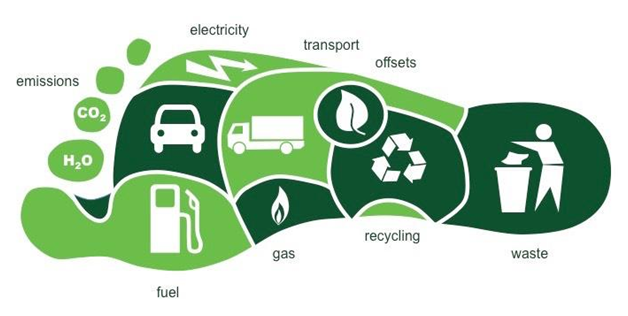
Climate change has wrecked havoc on people’s lives and the planet through severe acts of nature in recent times. Floods in Europe and Asia, wildfires, and extreme heatwaves in the United States, Canada, Siberia, Greece, and other parts of the world have been the center of discussion in 2021. The UN released a report titled “code red” for humanity, warning that human activity has pushed the planet to the brinks. If humankind does not reduce the amount of greenhouses gasses emitted into the atmosphere, there will be no future. Several media outlets, scientists, and environmentalists are now calling on everyone to do their part in reducing their carbon footprint for a sustainable planet. Many countries, companies, and institutions have shown commitment to reducing their emissions, with the EU setting a goal of being climate natural by 2050. The question hence for each of us is: “in what practical ways can we share in reducing carbon in the air for a better future?
How Do We Define Our Carbon Footprint?
The dreaded greenhouse gases that fuel climate change are largely produced through the consumption and production of goods and services. The more humans consume goods whose production involves releasing unhealthy gases into the atmosphere, the larger the carbon footprint. Carbon footprint is a method or concept of quantifying the impact of a country, person, or activity on climate change. For instance, the action of producing a t-shirt and a phone emits carbon, and the carbon footprint is essentially the quantity of that emission. Another example would be in the transport industry; a plane would emit 285g of carbon in one Kilometer of travel, compared to 14g or train, and 104g for car travel in the same distance.
In the United States, one person contributes to an average of 16 tons carbon footprint yearly, the highest in the world. The average global carbon footprint is 4 tons, which is considered excessive. It is estimated that this amount should drop below 2 tons by 2050 if the world is to avoid a 2℃ rise in temperature. Individual carbon footprint reduction to 2 tons a year does not happen in a flash; it takes time. Some small actions that you can make to reduce your carbon footprint include the following – line-drying clothes, eating less, taking public transport, switching the lights off when not used, and so on.
The Growing Impact Of Population Growth on Our Carbon Footprint
The world has approximately seven billion people, and each person consumes varying amounts of the earth’s resources. The UN estimates that the world population will reach 9.7 billion by 2050 and rise above 11 billion by 2100. With rising population growth, the planet’s resources will get depleted, and carbon emissions will also rise. Increasing greenhouse gas emissions through human action have a direct effect on global warming and climate change. Every individual can contribute to minimizing global warming through climate-friendly daily choices, no matter how small. Instead of simply thinking that the burden of protecting our environment purely lies on the government, we can all take ownership in protecting the environment through personal choices that add up over time.
How You Can Limit Your Carbon Footprint
It is important to understand your carbon footprint to help limit every consumption and purchase you make on the environment. The internet has different solutions and calculators to help you with an estimation of your carbon footprint. These calculators will help you determine which activity is a major contributor and what action you can take to be environmentally-friendly. Though some changes may look small, they can go a long way in reducing pollution contribution. For instance, positive changes in food consumption, transportation, clothing, waste disposal, and more can help the planet recover from environmental damage.
Food
Your total greenhouse gas emission can also be reduced by minimizing electricity usage and a change in lifestyle choices, including the food you eat. Changing your diet is an easy way to start reducing your environmental impact. Interestingly, some research shows that switching from western foods to more natural eating patterns could reduce water usage by 50% and minimize greenhouse gas emissions by approximately 70%. Let’s look at a few tips to implement in your food department to sustain the planet.

Stop wasting food
Food thrown away contributes immensely to carbon footprint because it decomposes in landfills, thus emitting methane into the atmosphere. Some statistics show that in the past 100 years, methane has overtaken carbon dioxide as the greatest contributor to global warming. Therefore, by reducing food wastage, individuals can easily decrease their carbon footprint. Plan your meals ahead of time, cooking only the food you need and save leftovers for later consumption.
Ditch Plastic
Plastic has wounded both land and marine life by its sheer amount of greenhouse gas release. When buying food at the grocery stores and supermarkets, carry biodegradable bags and use fewer plastic bags, wrapping, storage containers. You could avoid or reduce the take-out food you buy.
Eat less meat:
Several researchers indicate that reducing meat intake is ideal for lowering one’s carbon footprint. Carbon emissions from livestock production-dairy and beef cattle contribute to 14.5% of the world’s human-engineered greenhouse gas. Large portions of forests are being cleared for cattle rearing, and the beef and dairy industries add salt to the injury by spewing tons of carbon in the air. Reducing meat consumption will mean reduced demand, thus reducing production.
Purchase Local Food
Purchasing from local farmers will improve their economic well-being and minimize the amount of imported food. Reduced food importation means reduced carbon emission as well.
Transportation
The Covid-19 lockdown helped some countries to witness a blue sky after a long period. The sheer number of cars, planes, and industries have contributed to a huge amount of greenhouse gas release and global warming. There are several practical steps each individual can take to reduce carbon footprint through transportation.

Use public transport
A public means of transportation, such as train and public busses, will minimize cars on the road, traffic, and carbon emitted in the air. Some countries have invested in modern trains and busses with reduced carbon emissions to help the environment.
Use car-sharing and rental services
Car-sharing is the future and ideal for the planet’s future. Companies like Shariot offer you comfort car ownership through their car-sharing and rental services. The company envisions a world where car ownership will not be admired, and that it is made redundant with car sharing and car rental services. Shariot prides itself as a green champion through its eco-friendly ideals; therefore, instead of buying a car, use its affordable prices and change the environment.
Take fewer flights
Airplanes are major contributors to global warming in the transport industry, and the fewer trips you take with them, the better the planet becomes.
Take a bike
Bikes have no carbon release in the air apart from their manufacturing process. Taking a bike to work or on a trip will keep you fit, healthy and help eliminate carbon emissions in the air.
Clothing
The clothing industry is constantly changing, and consumers are encouraged each day to buy trendy fashion. The UN estimates that making one pair of jeans need one kilogram of cotton, which needs approximately 7,500-10,000 liters of water. The apparel manufacturing companies also emit tons of greenhouse gases into the air, and the less one wears, the less the carbon footprint. You could take practical steps, such as taking good care of your clothes and purchasing less. Instead of going for new cheap clothes, buy few quality ones that last or those made from recycled materials.
Energy preservation

Though clean sources like wind and solar produce some energy, most electricity around the globe is generated through power plants. These power plants often burn fossil fuels, including biofuels, natural gas, coal, or nuclear, for heating water and steam production. The steam is used in spinning the turbines for electricity production fed into the utility grid. In the United States, electric power plants are one of the biggest contributors to GHG emissions.
You can reduce your carbon print by preserving electricity and ensuring efficient usage. Using energy saver bulbs can reduce your consumption by 75%, and the more people implement this strategy, the more electricity is saved that can be used to power many homes for a long time. Take short showers to preserve water and electricity. Also, you can begin by turning off the water when washing dishes and brushing your teeth to save on water.
The Takeaway
The world is facing a carbon crisis, but with several emphases on reducing our carbon footprint, the masses are beginning to improve their awareness of the need to be carbon cautious. Everybody can have a small contribution that can snowball into a huge contribution in remedying the problem of GHG. Some steps, such as choosing the right food, reducing wastage, car-sharing transportation, and implementing energy preservation techniques, can help in reducing your carbon footprint.






No comment yet, add your voice below!